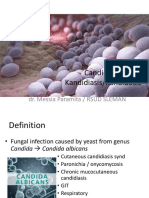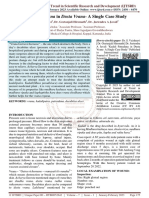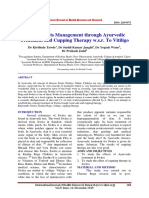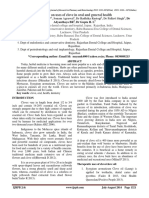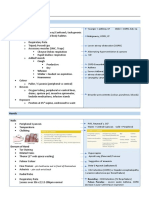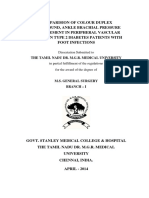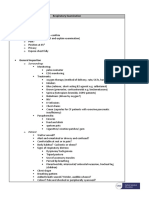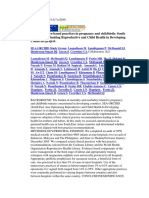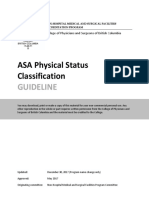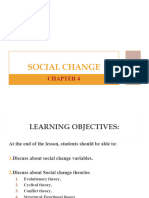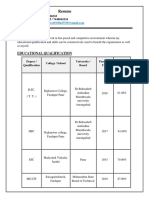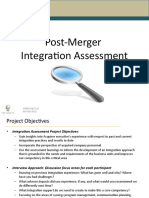Apache Iv
Apache Iv
Uploaded by
LUISCopyright:
Available Formats
Apache Iv
Apache Iv
Uploaded by
LUISOriginal Title
Copyright
Available Formats
Share this document
Did you find this document useful?
Is this content inappropriate?
Copyright:
Available Formats
Apache Iv
Apache Iv
Uploaded by
LUISCopyright:
Available Formats
Feature Articles
Acute Physiology and Chronic Health Evaluation (APACHE) IV:
Hospital mortality assessment for today’s critically ill patients*
Jack E. Zimmerman, MD, FCCM; Andrew A. Kramer, PhD; Douglas S. McNair, MD, PhD;
Fern M. Malila, RN, MS
Objective: To improve the accuracy of the Acute Physiology APACHE IV had good discrimination (area under the receiver
and Chronic Health Evaluation (APACHE) method for predicting operating characteristic curve ⴝ 0.88) and calibration (Hosmer-
hospital mortality among critically ill adults and to evaluate Lemeshow C statistic ⴝ 16.9, p ⴝ .08). For 90% of 116 ICU
changes in the accuracy of earlier APACHE models. admission diagnoses, the ratio of observed to predicted mortality
Design: Observational cohort study. was not significantly different from 1.0. We also used the valida-
Setting: A total of 104 intensive care units (ICUs) in 45 U.S. tion data set to compare the accuracy of APACHE IV predictions to
hospitals. those using APACHE III versions developed 7 and 14 yrs previ-
Patients: A total of 131,618 consecutive ICU admissions during ously. There was little change in discrimination, but aggregate
2002 and 2003, of which 110,558 met inclusion criteria and had mortality was systematically overestimated as model age in-
complete data. creased. When examined across disease, predictive accuracy was
Interventions: None. maintained for some diagnoses but for others seemed to reflect
Measurements and Main Results: We developed APACHE IV changes in practice or therapy.
using ICU day 1 information and a multivariate logistic regression Conclusions: APACHE IV predictions of hospital mortality have
procedure to estimate the probability of hospital death for ran- good discrimination and calibration and should be useful for
domly selected patients who comprised 60% of the database. benchmarking performance in U.S. ICUs. The accuracy of predic-
Predictor variables were similar to those in APACHE III, but new tive models is dynamic and should be periodically retested. When
variables were added and different statistical modeling used. We accuracy deteriorates they should be revised and updated. (Crit
assessed the accuracy of APACHE IV predictions by comparing Care Med 2006; 34:1297–1310)
observed and predicted hospital mortality for the excluded pa- KEY WORDS: intensive care unit; patient outcome assessment;
tients (validation set). We tested discrimination and used multiple severity of illness index; prognostication; health outcome research;
tests of calibration in aggregate and for patient subgroups. informatics
S coring systems based on phys- inclusion criteria for study enrollment, inadequate diagnostic data (6), unreliable
iologic abnormalities have and for risk stratification in outcome com- Glasgow Coma Scale (GCS) score assess-
been successful in measuring parisons. Examples include Acute Physiol- ment (7, 8), international and regional
severity of illness among criti- ogy and Chronic Health Evaluation differences (9, 10), variations in patient
cally ill patients. Severity scores are used (APACHE) III (1), Simplified Acute Phys- referral patterns (11, 12), and differing
in clinical research to demonstrate equiv- iology Score (SAPS) II (2), and the Mor- selection for and timing of ICU admission
alency of study and control patients, as tality Probability Model (MPM) II (3). (13). In addition, predicted outcomes are
Each of these prognostic models has been likely to be influenced by changes in the
used to compare observed outcomes to a effectiveness of therapy over time (5, 6),
*See also p. 1538. case-mix-adjusted benchmark for hospi- the frequency of decisions to forgo life-
From the George Washington University, Washington, tal mortality based on outcomes that re- sustaining therapy (14), care before and
DC (JEZ); and Cerner Corporation, Vienna, VA (JEZ,
AAK, FMM) and Kansas City, MO (DSM). flect the efficacy of treatment during after ICU admission (13, 15), and the fre-
Supported by Cerner Corporation, Kansas City, MO. 1988 –1992. quency of early discharge to skilled nurs-
Dr. Zimmerman provides consulting services to Studies using APACHE III, SAPS II, ing facilities (16).
Cerner Corp.; Dr. Kramer is an employee of and has and MPM II within independent intensive Strategies suggested to improve the
stock ownership and stock options in Cerner Corp.; Dr.
McNair is an employee of, holds equity interest, stock care unit (ICU) databases have reported a accuracy of prognostic models include a)
ownership, and stock options in, and has patents for predicted mortality that was significantly reestimating the coefficients for each
Cerner Corp.; Ms. Malila is an employee of and has different from observed (4, 5). These dif- original variable for a specific population;
stock ownership and stock options in Cerner Corp. ferences between observed and expected or b) adding a population-specific vari-
Address requests for reprints to: Andrew A.
Kramer, PhD, 1953 Gallows Road, Suite 570, Vienna,
mortality might have been caused by able customized to the original model
VA 22182. poor model design, variations in quality (17). Both types of customization have
Copyright © 2006 by the Society of Critical Care of care, or inadequate case-mix-related resulted in improved calibration for ag-
Medicine and Lippincott Williams & Wilkins adjustment. Proposed reasons for inade- gregate patient samples but have not ad-
DOI: 10.1097/01.CCM.0000215112.84523.F0 quate case mix adjustment have included equately adjusted for poor uniformity of
Crit Care Med 2006 Vol. 34, No. 5 1297
fit within patient subgroups (5, 18 –20). proved predictive model that is available spectively for consecutive unselected intensive
These findings suggest that recalibrated in the public domain. or coronary care unit admissions. Informed
models fail to account for important pa- consent was not obtained because of Institu-
tient risk factors and that remodeling is tional Review Board waivers during prior stud-
METHODS
needed. ies (1). We excluded and did not collect data
The data for this study consisted of a non- for patients who had been admitted for ⬍4
Since APACHE III was published (1, 21),
randomized observational cohort of 131,618 hrs, patients with burns, patients ⬍16 yrs of
we have repeatedly assessed its calibration age, and except for hepatic and renal trans-
consecutive ICU admissions. Data were col-
using patient data collected during subse- plantation, patients admitted after transplant
lected for patients admitted between January
quent time periods. For patient data col- operations. We excluded patients missing an
1, 2002, and December 31, 2003, at 104 inten-
lected between 1993 and 1996, the original acute physiology score on ICU day 1 and those
sive or coronary care units in 45 hospitals. The
APACHE III model (version H) had a stan- 104 units were selected because each had in- remaining in hospital for ⬎365 days. To avoid
dardized mortality ratio (SMR) of 1.01 in stalled an APACHE III computerized data col- counting more than one hospital outcome for
the entire patient sample, but calibration the same patient, analysis included only a pa-
lection and analysis system. Each hospital pro-
was not perfect (Hosmer-Lemeshow statis- tient’s first ICU admission. We also excluded
vided information about the type of ICU where
tic ⫽ 48.71, p ⬍ .01) (22). In 1998, from analysis patients admitted from another
data were collected, hospital bed size, geo-
APACHE III version H was revised and up- ICU during the same hospitalization. We did
graphic location, and teaching status. Patient
this because extensive life support before ICU
dated using data collected between 1993 data were entered on site using a software admission biases the prognostic implications
and 1996. The revised model (APACHE program that included computerized pick of first ICU day physiologic measures. Out-
III version I) had an SMR ⫽ 1.00 and lists, automated error checks, and calculation comes recorded for each patient included the
a Hosmer-Lemeshow statistic ⫽ 24.2 of physiologic means and gradients. Some exact duration (in hours) of ICU and hospital
(p ⬍ .01) in the validation set (unpublished units entered data via electronic interfaces length of stay and mortality at ICU and hospi-
data). In 2004 we reassessed the accuracy of with laboratory and clinical information sys- tal discharge.
APACHE III version I using patient data tems. The procedures used for data collection The data collected for each patient are
collected between 2002 and 2003. The SMR were based on prior reliability studies (1, 24) summarized in Table 1. The data included age,
was 0.93 and the Hosmer-Lemeshow statis- and field experience (16). Our methods for chronic health conditions, and physiologic
tic ⫽ 273.6 (p ⬍ .001). These results indi- training data collectors and for ensuring ac- data required to calculate an acute physiology
cated that this equation needed to be re- curacy have been previously described (22). score (APS) of APACHE III. The APS was based
Patient Information and Exclusions. Pa- on the worst measurement for each compo-
modeled.
tient data generated as a result of patient care nent on ICU day 1. Each of the three variables
We had a different experience in assess-
and recorded in the medical record were col- rather than the composite APACHE III score
ing the calibration of the equation that pre- lected concurrently or in some cases retro- was used in the mortality model. We also re-
dicts hospital mortality for patients admit-
ted after coronary artery bypass graft
(CABG) surgery. The original APACHE III Table 1. Data items collected and used for predicting hospital mortality among patients admitted to
model for predicting hospital mortality af- intensive care unit (ICU) who did not have coronary artery bypass graft (CABG) surgery
ter CABG surgery (23) was poorly cali-
brated when tested using 1993–1996 pa- Age Continuous Measure Plus Five Spline Terms
APS variables Weight determined by most abnormal value within first
tient data and was therefore remodeled
APACHE day; sum of weights equals the APS, which ranges
using data for patients admitted between from 0 to 252. Five spline terms added. Variables include
1993 and 1996. The SMR was 1.00 and pulse rate, mean blood pressure, temperature, respiratory
the Hosmer-Lemeshow statistic ⫽ 11.0 rate, PaO2/FIO2 ratio (or P(A-a)O2 for intubated patients with
(p ⬎ .10) for the complete data set (unpub- FIO2 ⱖ 0.5), hematocrit, white blood cell count, creatinine,
lished data). When this equation was reval- urine output, blood urea nitrogen, sodium, albumin,
idated in 2004 using data collected during bilirubin, glucose, acid base abnormalities, and neurological
2002 and 2003, the SMR was 0.997. abnormalities based on Glasgow Coma Score
In this report, we describe APACHE Chronic health variables AIDS, cirrhosis, hepatic failure, immunosupression,
lymphoma, leukemia or myeloma, metastatic tumor. Not
IV, an improved and updated model for
used for elective surgery patients
predicting group hospital mortality ICU admission diagnosis 116 categories (see Appendix Tables 1 and 2)
among critically ill patients and the pre- ICU admission source Floor, emergency room, operating/recovery room, stepdown
viously remodeled equation for predict- unit, direct admission, other ICU, other hospital, other
ing hospital mortality after CABG sur- admission source
gery. Instead of developing a new Length of stay before Square root plus four spline terms
APACHE IV score, our remodeling efforts ICU admission
Emergency surgery Y/N
were built on the success of severity scor- Unable to assess Glasgow Y/N
ing using the physiologic variables and Coma Scale score
weights of APACHE III. Our efforts, how- Thrombolytic therapy For patients with acute myocardial infarction (Y/N)
ever, went beyond fitting a new logistic Glasgow Coma Scale 15 minus measured Glasgow Coma Scale score
regression equation and developing new score rescaled
PaO2/FIO2 ratio
coefficients for each variable in a new ICU Mechanical ventilation Y/N
patient sample. Instead, using recent pa-
tient data we developed new predictor APS, acute physiology score; APACHE, Acute Physiology and Chronic Health Evaluation.
variables and used refined statistical All predictor variables use ICU day 1 data.
methods to develop and validate an im-
1298 Crit Care Med 2006 Vol. 34, No. 5
corded the primary reason for ICU admission ships with outcomes using restricted cubic whether a patient had diabetes, were added
(ICU admission diagnosis), the patient’s loca- regression splines (25). Splines allow estima- during remodeling in 1998. This analysis also
tion (admission source), length of stay before tion of a nonlinear relationship between a used a restricted cubic spline transformation
ICU admission, whether a patient received me- variable and an outcome and replace less ac- similar to that used for non-CABG patients.
chanical ventilation or underwent emergency curate techniques that assume the relation- Analysis. The APACHE IV hospital mortality
surgery, PaO2/FIO2 ratio, and whether sedation ship is linear. Cut points (knots) are chosen equation was estimated using a randomly se-
or paralysis resulted in an inability to assess and a separate coefficient is included for each lected patient group that comprised 60% of the
GCS score. interval between knots. A restricted cubic database (training set). We then compared ob-
Each patient’s primary reason for ICU ad- spline transformation (26) was used to expand served and predicted hospital mortality for indi-
mission (ICU admission diagnosis) was re- age and the APS to five nonlinear terms and vidual patients within the excluded group (vali-
corded by selecting one of 430 diseases, inju- previous length of stay to four nonlinear dation set): The default categories with a zero
ries, surgical procedures, or events that was terms. The prior length of stay variable was coefficient (reference patient) had the following
most immediately threatening to the patient measured as a continuous rather than an in- characteristics. Admission diagnosis of acute
and required the services of the intensive or teger variable as was done in APACHE III. myocardial infarction (other), no emergency
coronary care unit. Each ICU admission diag- Among the items listed in Table 1, four were surgery, admitted to ICU directly or from emer-
nosis was first classified as nonoperative or tested as new predictor variables: a) whether a gency room or a stepdown unit, no chronic
postoperative, next by body system or a trans- patient was mechanically ventilated; b) health item, APS ⫽ 0, able to have GCS mea-
plant or trauma-related category, and then by whether a patient with acute myocardial in- sured, GCS of 15, and not on a ventilator. All
diagnosis. A residual “other” category was farction received thrombolytic therapy; c) an calculations were performed using SAS version
used for unlisted diagnoses within each body adjustment for the differing prognostic impli- 9.1 (SAS Institute, Cary, NC) and S-Plus 6.2
system, transplant, and trauma category. For cations of the GCS and PaO2/FIO2; and d) the (Insightful Corporation, Seattle, WA). To com-
patients with acute myocardial infarction we impact of inability to assess GCS due to seda- pare observed and predicted mortality for all ICU
recorded infarct location (anterior, inferior, tion or paralysis. The later variable was tested admissions and across patient subgroups, we
lateral, non-Q-wave, posterior, other, un- as a means for reducing predictive inaccura- calculated an SMR by dividing observed by mean
known) and whether the patient received cies caused by defaulting GCS to normal when predicted hospital mortality.
thrombolytic therapy within 24 hrs pre- or assessment was not possible (8). To assess the accuracy of APACHE IV hos-
post-ICU admission. We examined the 430 ICU admission diag- pital mortality predictions within the valida-
Data collected for patients admitted after noses to determine whether there were a suffi- tion set, we used multiple analytic methods. To
CABG surgery are summarized in Table 2. Mea- cient number of patients and deaths to enable us test the ability of the model to distinguish pa-
surements that were unique for patients admit- to create a greater number of specific diagnostic tients who die from patients who live (discrimi-
ted after CABG surgery included female gender, categories than included in APACHE III. New nation), we used the area under a receiver oper-
number of grafts, whether an internal mammary categories were selected based on their fre- ating characteristic curve (AU-ROC) (27). Values
graft was used, and whether the patient had quency, their clinical homogeneity, and the im- above 0.80 indicate good discrimination. To
diabetes, prior CABG surgery, or myocardial in- pact of each diagnosis on hospital mortality. test the degree of correspondence between ob-
farction during the current hospitalization. A Unlisted and infrequent diagnoses were placed served and predicted mortality over the entire
detailed description of these demographic, into residual body system related “other” cate- range of risk (calibration), we used three
clinical, and physiologic variables has been gories. This resulted in an increase in the num- methods. First, we graphically displayed cali-
previously reported (1, 21, 22) and is avail- ber of diagnostic categories from 78 in the 1991 bration by plotting observed and predicted
able along with instructions for their calcu- APACHE III, version H model (21, 22) to 116 in mortality across all risk ranges (28). Second,
lation and use in predicting hospital mortal- APACHE IV. A list of the 430 ICU admission we used goodness-of-fit testing to evaluate cal-
ity at www.criticaloutcomes.cerner.com. diagnoses and the 116 mapped categories used ibration across deciles of risk using the Hos-
Development of the APACHE IV Model for for APACHE IV predictions are available at www. mer-Lemeshow C statistic (29). Third, we used
Predicting Hospital Mortality. For each pa- criticaloutcomes.cerner.com. a Cox chi-square test to evaluate the equiva-
tient we estimated the probability of hospital Table 2 displays the variables used in a lence of observed and predicted hospital mor-
mortality using a multivariate logistic regres- multivariate logistic regression procedure for tality in aggregate and within subgroups de-
sion procedure. The predictor variables used estimating the probability of hospital mortal- fined by each predictor variable. A significance
by the APACHE IV model for patients who did ity for patients admitted after CABG surgery. criterion of p ⬍ .01 was chosen because of the
not have CABG surgery are shown in Table 1. Among the ten predictor variables shown, large sample size and the large number of
The age, APS, and prior length of stay vari- eight have been previously reported (23) and statistical tests across multiple subgroups.
ables were allowed to have nonlinear relation- two, length of stay before ICU admission and Odds ratios were computed by taking expX,
where X is the value of a variable’s coefficient
in the model. The contribution of each risk
Table 2. Data items collected and used for predicting hospital mortality among patients admitted to component was based on its reduction to the
intensive care unit (ICU) after coronary artery bypass graft (CABG) surgery full model’s log likelihood. To do this we as-
sessed the difference in log likelihood of the
Age; yrs 0–45, 46–55, 56–60, 61–65, 66–70, 71–75, 76–85, 85⫹ intercept-only model and the full model,
Acute physiology score variables Four spline terms added (described in Table 1). which is the explainable variation. The differ-
Emergency surgery Y/N ence in log likelihood for models excluding
Prior CABG surgery Y/N each risk component was built and compared
Female gender Y/N vs. the full model. The difference was then
Number of grafts Y/N for six variables for 2, 3, 4, 5, 6, and 7 grafts,
divided by the explainable variation. We have
respectively.
Internal mammary artery graft Y/N
compared observed and predicted hospital
Myocardial infarction during Y/N mortality across ICUs but will report these
current hospitalization results in a future analysis.
Length of stay before ICU admission Square root To assess the impact of excess length of
Diabetes Y/N hospital stay on the mortality model, we de-
veloped an equation that included a term that
All predictor variables use ICU day 1 data. was used in previous APACHE mortality mod-
Crit Care Med 2006 Vol. 34, No. 5 1299
els (21, 22). This term was derived by calcu- IV model for predicting hospital mortality farction, other” was the default category
lating the expected hospital length of stay for among patients without CABG surgery, with no separate coefficient). Thus a total of
survivors, calculating the residual (observed ⫺ 21,137 patients were excluded for the fol- 142 variables were included in the model
expected) for each individual, and then obtain- lowing reasons: a) missing APS on day 1 resulting in an average of 42 deaths per
ing the mean residual for each ICU. This vari-
(n ⫽ 450); b) remaining in the hospital variable in the validation data set. This in-
able was used to address institutional factors
that keep patients in the hospital longer and
⬎365 days (n ⫽ 112); c) second or mul- dicates that the full model did not contain
thus increase their likelihood of hospital tiple ICU admissions (n ⫽ 8,735); d) ad- too many variables relative to the number
death. The accuracy of mortality prediction mission from another ICU (n ⫽ 2,760); of outcomes.
using the excess length of stay term was com- and d) undergoing CABG surgery (n ⫽ Analysis of Aggregate Discrimination
pared with the model not including the added 9,180). These exclusions left 110,558 and Calibration. The results from apply-
terms by comparing ⫺2 log likelihood for patients for model development and ing the APACHE IV model for non-CABG
each model. validation. surgery patients to the validation data set
Mortality Predictions Over Time. To eval- The demographic and clinical charac- are given in Table 4. The observed and
uate the need to reassess and update models teristics of the 110,558 patients are mean predicted mortality were 13.51%
for predicting hospital mortality, we applied
shown in Table 3, and Figure 1 shows the and 13.55%, respectively, for an SMR ⫽
the APACHE IV model and two earlier versions
of APACHE III to the current (2002–2003)
distribution of first ICU day acute physi- 0.997 ( p ⫽ .76). AU-ROC was 0.88 indi-
validation data set. The two earlier versions ology scores. Appendix Table 1 lists the cating that the model had excellent dis-
were a) APACHE III, version H, which was 75 nonoperative and Appendix Table 2 the crimination. The Hosmer-Lemeshow chi-
developed and validated using patient data 41 postoperative ICU admission diag- square was 16.8 (10 df, p ⫽ .08), which is
from 1988 to 1989 and included statistically noses used by the APACHE IV model. In not significant (on the validation set 10 df
independent equations for 78 disease catego- aggregate, the 12 most frequent ICU ad- was used; see Ref. 30, page 188). The
ries (1, 21); and b) APACHE III, version I, mission diagnoses accounted for 29.8% model had an adjusted R2 ⫽ .44, indicat-
which was developed and validated using pa- of all admissions. The 13 residual “other” ing that it accounted for 44% of the vari-
tient data from 1993 to 1996 and included categories (eight nonoperative and five ation in outcomes. The relative explana-
statistically independent equations for 94 dis-
postoperative) accounted for 12.2% of tory power for the predictor variables is
ease categories (unpublished data). For each
model we used the 2002–2003 validation set to
nonoperative and 17.8% of postoperative shown in Figure 2. The most important
assess aggregate discrimination using the AU- admissions. variable was the APS, followed by disease
ROC, calibration using a Cox chi-square test to The APACHE IV Model for Predicting group and age. Table 5 shows the ob-
evaluate the equivalence of observed and pre- Hospital Mortality. Variables included in served and mean predicted mortality
dicted hospital mortality, and goodness-of-fit the predictive model are shown in Table 1. rates by risk deciles. The largest differ-
using the Hosmer-Lemeshow C statistic (29). The variables include the APS plus addi- ence by decile was 1.6%, which occurred
We used the same models and validation set to tional spline terms, age plus additional in the ⬎90 –100% decile. Figure 3 graph-
assess the equivalence of observed and pre- spline terms, square root of the previous ically displays the close relationship be-
dicted mortality across disease subgroups that length of stay plus additional spline terms, tween observed and mean predicted mor-
were selected according to clinical impor-
emergency surgery, whether a patient was tality across risk deciles.
tance, frequency, and uniformity of definition.
ventilated on ICU day 1, a rescaled GCS Analysis of Predictive Accuracy
score, inability to assess GCS due to seda- Within Patient Subgroups. Because
RESULTS
tion or paralysis, thrombolytic therapy for splined variables generate predictions
Characteristics of Hospitals and Crit- patients with acute myocardial infarction, based on nonlinear terms, their contribu-
ical Care Units. Of the 45 hospitals stud- seven chronic health items, three variables tion as APACHE IV predictor variables is
ied, 15 (33%) were members of the Coun- for location before ICU admission, PaO2/ best viewed by examining risk over
cil of Teaching Hospitals, 13 (29%) were FIO2 ratio, and 115 categorical variables for ranges of the variables. The coefficients
teaching hospitals that were not mem- admission diagnoses (“acute myocardial in- and mortality probabilities for differing
bers of the Council of Teaching Hospitals,
and 17 (38%) were nonteaching hospi-
tals. The mean number of hospital beds Table 3. Demographic and clinical characteristics of 110,558 patients admitted to 104 U.S. intensive
was 478 (range 50 –1,030 beds). Among care units between January 1, 2002, and December 31, 2003
the 45 hospitals, 11 (24%) had ⬍300
Training Data Set Validation Data Set
beds, 11 (24%) had 300 –399 beds, eight
(n ⫽ 66,270) (n ⫽ 44,288)
(18%) had 400 –524 beds, seven (16%)
had 525–799 beds, and eight (18%) had Age, yrs 61.51 ⫾ 0.07 61.45 ⫾ 0.08
ⱖ800 beds. Geographically, 17 (38%) Acute physiology score 38.83 ⫾ 0.10 38.72 ⫾ 0.12
were located in the Southeast, 14 (31%) Prior length of stay, square root days 0.786 ⫾ 0.004 0.777 ⫾ 0.005
in the West, nine (20%) in the Midwest, PaO2/FIO2 ratio 332.70 ⫾ 0.41 332.46 ⫾ 0.50
Died in hospital, % 13.6 13.5
and five (11%) in the Northeast. Among One or more APACHE comorbidities, % 10.4 10.6
the 104 units that participated in the Emergency surgery 5.7 5.5
study, 40 were mixed medical-surgical, Unable to assess GCS due to sedation, % 8.0 8.1
17 coronary care, 14 surgical, 12 cardio- Ventilated on day 1, % 35.1 35.1
Postoperative patient, % 30.9 30.8
thoracic, 11 medical, seven neurologic,
Gender, % male 54.2 54.2
and three trauma. Race, % white 69.3 69.5
Exclusions and Patient Characteris-
tics. To develop and validate the APACHE APACHE, Acute Physiology and Chronic Health Evaluation; GCS, Glasgow Coma Score.
1300 Crit Care Med 2006 Vol. 34, No. 5
Figure 1. Distribution of intensive care unit day 1 acute physiology score.
Table 4. Comparison of discrimination and calibration of the Acute Physiology and Chronic Health
Evaluation (APACHE) IV mortality model and earlier APACHE III versions when applied to the same
2002–2003 validation data set (n ⫽ 44,288)
APACHE III— APACHE III—
Version APACHE IVa Version Ib Version Hc
Observed mortality rate, % 13.51 13.51 13.51
Predicted mortality rate, % 13.55 14.64 16.90
SMR, observed/predicted 0.997 ( p ⫽ .79) 0.923 ( p ⬍ .001) 0.799 ( p ⬍ .001)
Area under the ROC curve 0.880 0.870 0.868 Figure 2. Unique relative contribution of each
Hosmer-Lemeshow 2 16.8 ( p ⫽ .08) 124.6 ( p ⬍ .001) 635.4 ( p ⬍ .001) risk factor to hospital mortality prediction. The
acute physiology category includes the acute
ROC, receiver operating characteristic curve. physiology score of Acute Physiology and
a
APACHE IV was validated using data for 44,288 admissions to 104 intensive care units during 2002 Chronic Health Evaluation III, inability to assess
and 2003; bAPACHE III version I was developed using data for 40,264 admissions to 188 intensive care Glasgow Coma Scale, and rescaled Glasgow Coma
units during 1993 and 1996 (unpublished data); cAPACHE III version H was developed using data for Scale and PaO2/FIO2 ratio. The admission vari-
16,662 admissions to 42 intensive care units during 1988 and 1989 (Refs. 2, 23). ables include patient admission source and
length of stay before intensive care unit admis-
sion. The diagnosis category includes 116 mutu-
values of the APS, for age, and for previ- (25%) had significant coefficients and 54 ally exclusive primary reasons for intensive care
ous length of stay are shown in Table 6. (47%) had p values ⬍.10. The diagnoses unit admission, emergency surgery, and throm-
The coefficients for each of these spline for non-CABG surgery patients and the bolytic therapy for patients with acute myocar-
terms are automatically calculated at observed and mean predicted mortality, dial infarction.
www.criticaloutcomes.cerner.com. The SMR, regression coefficient, and odds ra-
influence of the APS was more pro- tio for each diagnosis in the validation set Overall, there was no significant difference
nounced than that for age, and the latter are shown in Appendix Tables 1 and 2. (p ⬍ .01) between observed and mean pre-
was more influential than previous Among the 116 ICU admission diagnoses, dicted mortality for 105 (91%) of the 116
length of stay. Figure 4 shows how risk there was no significant difference diagnostic groups. Of the 11 significantly
increased with increasing APS within (p ⬍ .01) between observed and mean pre- different diagnostic groups, seven had
four diagnostic groups. dicted hospital mortality for 65 (87%) of SMRs ⬍1.00 and four had SMRs ⬎1.00.
Among the 116 ICU admission diag- the 75 nonoperative diagnoses and 40 For the residual “other” diagnostic catego-
noses used in the APACHE IV model, 29 (98%) of the 41 postoperative diagnoses. ries listed in Appendix Tables 1 and 2, there
Crit Care Med 2006 Vol. 34, No. 5 1301
Table 5. Observed and predicted hospital mortality rates across risk deciles within the validation data operating/recovery room, which had an
set (n ⫽ 44,288) odds ratio of 0.56. The SMR for each
admission sources was close to 1.0.
Observed Deaths Predicted Deaths
Each nonsplined APACHE IV predictor
Risk Decilea No. (%) No. (%) Difference, %
variable and its regression coefficient are
1 24 (0.5) 21 (0.5) 0.1 also available at www.criticaloutcomes.
2 30 (0.7) 44 (1.0) ⫺0.3 cerner.com. This Web site also provides the
3 70 (1.6) 73 (1.6) ⫺0.1 ability to automatically calculate spline
4 100 (2.3) 113 (2.6) ⫺0.3 terms for APS, age, and previous length of
5 182 (4.1) 172 (3.9) 0.2
6 264 (6.0) 263 (5.9) 0.0 stay and to apply both splined and non-
7 420 (9.5) 417 (9.4) 0.1 splined terms to arrive at an individual’s
8 751 (17.0) 700 (15.8) 1.1 prediction of mortality.
9 1,331 (30.1) 1,314 (29.7) 0.4 Impact of Excess Hospital Length of
10 2,813 (63.5) 2,883 (65.1) ⫺1.6
Stay on Mortality Prediction. When the
a
Risk decile: population sorted by increasing predicted risk and then split into deciles. Sum of variable reflecting excess length of hospital
(observed ⫺ expected)2/expected ⫽ 2 ⫽ 16.8, df ⫽ 10, p ⫽ .08. stay was added to the APACHE IV model, it
was highly significant (likelihood ratio chi-
square ⫽ 73.8, p ⬍ .001). When compared
with the model without that term, there
was a decline in goodness-of-fit (Hosmer-
Lemeshow chi-square went from 16.8 to
25.9) but no change in discrimination (AU-
ROC ⫽ 0.88 for both models) or SMR
(0.997 for both models). Because the ex-
cess length of hospital stay variable did
not improve model performance and is
logistically difficult to calculate, it was
not included in the APACHE IV model.
Mortality Prediction for Patients Ad-
mitted After CABG Surgery. The original
model for predicting hospital mortality
after CABG surgery (23) was remodeled
in 1998 using data for 3,689 patients ad-
mitted during 1993 through 1996. The
remodeled equation (APACHE III–CABG,
version I) was revalidated using our cur-
rent data for 9,180 patients admitted dur-
ing 2002 and 2003. Observed mortality
was 2.16% and predicted mortality was
Figure 3. Calibration curve comparing observed and predicted hospital mortality rates across 10% 2.16% for an SMR of 0.997 (chi-square ⫽
intervals of predicted risk and distribution of risk for the 44,288 intensive care unit admissions in the 0.002, p ⫽ .96). Given the low mortality
validation data set. The 45° line indicates perfect predictive ability. The line connecting triangles plots rate and excellent SMR, we did not re-
the number of patients in each risk group. model this equation and have included it
as a part of APACHE IV.
was no significant difference between ob- rescaled GCS was 1.04 for each 1-point APACHE Mortality Predictions Over
served and mean predicted hospital mortal- increase in score, apart from the increase Time. Aggregate hospital mortality predic-
ity for 12 (92%) of the 13 categories. in the APS that would also occur. Thus a tions using APACHE IV and APACHE III,
Appendix Table 3 shows observed and patient with a rescaled GCS ⫽ 12 (mea- versions H and I, in the current validation
mean predicted mortality, SMR, odds ra- sured GCS ⫽ 3) had an odds ratio of 1.60 data set are shown in Table 4. Discrimina-
tio, and the coefficients for each non- compared with a patient with a rescaled tion did not decline for the three models,
splined variable. The odds ratios for pa- GCS ⫽ 0 (measured GCS ⫽ 15). Increas- but calibration as measured by the SMR
tients having emergency surgery, unable ing PaO2/FIO2 ratios decreased the mortal- and Hosmer-Lemeshow statistic declined
to have the GCS assessed, and ventilated ity probability slightly. Except for high for version I and deteriorated further for
on day 1 were all significantly greater values of PaO2/FIO2, the model’s predic- version H. Table 7 shows how applying the
than 1.00. The observed and predicted tions were close to the observed mortal- three models affected the SMR for diagnos-
mortality rates for these patients were ity. Each of the chronic health items had tic groups chosen because their frequency
within 1%. The odds ratio for patients significant odds ratios, which ranged and definitions were constant across ver-
with acute myocardial infarction who re- from 1.55 to 2.96. Except for patients sions. APACHE IV performed significantly
ceived thrombolytic therapy was 0.56. with lymphoma, the SMRs by chronic better than APACHE III version I for pa-
However, the SMR for this group was health item were close to 1.0. The various tients with sepsis (nonurinary tract), car-
1.54, which indicates poor calibration admission sources had a nonsignificant diac arrest, and noncardiac pulmonary
among these patients. The odds ratio for odds ratio, except for admission from the edema (acute respiratory distress syn-
1302 Crit Care Med 2006 Vol. 34, No. 5
Table 6. Mortality probabilities for various values of the acute physiology score (APS),a age,b and length drome) and significantly better than
of stayc given default or mean values for all other variablesd APACHE III version H for patients with the
same diagnoses and for patients with em-
95% Confidence Interval
Mortality physema/bronchitis and hepatic failure.
Probability, % Lower Upper
DISCUSSION
Acute physiology score
20 2.7 2.0 3.8 APACHE IV was developed because the
30 4.9 3.6 6.6 accuracy of APACHE III changed signifi-
40 7.8 5.8 10.6
50 11.5 8.5 15.2 cantly over the last decade. The APACHE IV
60 16.1 12.1 21.0 model has excellent discrimination (AU-
70 21.8 16.7 28.0 ROC ⫽ 0.88), and aggregate predicted hos-
80 28.8 22.4 36.0 pital mortality (13.51%) is statistically
90 36.7 29.3 44.8
100 45.5 37.2 54.0
identical to observed 13.55% (p ⫽ .76) for
Age, yrs the validation data set. Calibration is ex-
30 4.1 2.9 5.6 cellent with a nonsignificant Hosmer-
45 5.6 4.1 7.7 Lemeshow C statistic (16.8, p ⫽ .08) de-
60 7.2 5.3 9.7 spite the large validation sample size. The
70 9.8 7.2 13.0
80 13.2 9.9 17.4 difference between observed and mean
90 16.4 12.3 21.5 predicted hospital mortality across risk
Previous length of stay deciles is 0.1– 0.4% except for the 70 –
0 7.1 5.2 9.7 80% decile (1.1%) and 90 –100% decile
4 hrs 6.5 4.8 8.8
12 hrs 7.2 5.3 9.7
(1.6%). For most subgroups, the ratio of
1 day 8.2 6.0 11.0 observed to mean predicted hospital mor-
2 days 9.4 6.9 12.6 tality is near 1.0, and 90% of the SMRs
4 days 10.5 7.8 14.2 within disease groups are not signifi-
cantly different from 1.0. Although a
a
The coefficients for APS and the spline terms were 0.556, 0.000008719, ⫺0.00005, 0.00005,
smaller sample size for some disease
⫺0.0000131, and ⫺0.000000865. The last five coefficients emanate from using knots at APS ⫽ 10, 22,
32, 48, 89, respectively; bthe coefficients for age and the spline terms were 0.0242, ⫺0.00000439,
groups caused a low power of detection,
0.00005, ⫺0.00013, 0.000109606, and ⫺0.000027572. The last five coefficients emanate from using the relative magnitude of observed mor-
knots at age ⫽ 27, 51, 64, 74, 86, respectively; cthe coefficients for previous length of stay and the tality correlated well with that of pre-
spline terms were ⫺0.3105, 1.4747, ⫺2.8619, 1.4216590103, and ⫺0.034445822. The last four dicted risk. Because of its accuracy for
coefficients emanate from using knots at previous length of stay ⫽ 3 hrs, 10 hrs, 19 hrs, and 2.8 days, U.S. patients, APACHE IV can be used to
respectively; ddefault disease group is acute myocardial infarction (AMI) other, thrombolytic therapy benchmark ICU performance using ag-
⫽ no Glasgow Coma Scale (GCS) ⫽ 15, PaO2/FIO2 ⫽ 385.7, no chronic health items, direct admission, gregate SMRs to assess quality of care and
non-ventilated, unable ⫽ no, and emergency surgery ⫽ no. disease-specific SMRs to evaluate out-
comes for patient subgroups. To enhance
this application, APACHE IV has been
placed in the public domain via a Web site
spreadsheet that provides the ability to
predict individual patient mortality.
Several factors are likely to account
for the accuracy of APACHE IV mortality
predictions. First, APACHE IV is based on
the successful use of physiologic abnor-
malities for risk adjustment, which ac-
counted for 66% of the model’s explana-
tory power. Because the APS was splined
a simple odds ratio is not possible, but as
shown in Table 6 and Figure 3, the pre-
dicted mortality consistently increases
with an increasing APS. Second, the ac-
curacy of physiologic risk adjustment was
improved by adding rescaled PaO2/FIO2
and GCS variables and by reducing the
impact of defaulting the GCS to a normal
value when sedation or paralysis made
direct assessment impossible. Third, we
Figure 4. Relationship between first intensive care unit day acute physiology score (APS) and predicted improved case-mix adjustment by in-
mortality for four disease groups. Disease groups are indicated as follows: circles, head trauma creasing the precision of disease labeling.
(HEADTR); triangles, surgery for respiratory cancer (SRESPCA); squares, cardiac arrest (CARDARR); ICU admission diagnosis accounts for
diamonds, gastrointestinal vascular insufficiency (GIVASC). 17% of the model’s explanatory power,
Crit Care Med 2006 Vol. 34, No. 5 1303
Table 7. Standardized mortality ratio for selected disease groups when Acute Physiology and Chronic Health Evaluation (APACHE) IV, APACHE III version I, and
APACHE III version H predictions are used for the 2002–2003 validation data set (n ⫽ 44,288)
APACHE IVa APACHE III Version Ib APACHE III Version Hc
Observed Predicted Predicted Predicted
Disease Group No. Mortality, % Mortality, % SMR Mortality, % SMR Mortality, % SMR
Sepsis (nonurinary tract) 1,821 37.3 37.4 1.00 41.8 0.89d 45.2 0.83d
Cardiac arrest 872 58.3 58.4 1.00 53.1 1.10d 54.5 1.07e
Emphysema/bronchitis 878 15.1 13.4 1.13 17.4 0.87 19.8 0.76d
Noncardiac pulmonary 310 27.7 28.2 0.98 36.3 0.76d 34.0 0.82e
edema (ARDS)
Thoractomy for lung 633 4.1 4.3 0.96 3.5 1.16 5.2 0.80
neoplasm
Aortic aneurysm, elective 701 5.6 4.7 1.19 3.9 1.41 4.6 1.20
repair
Stroke 860 21.5 20.2 1.06 19.8 1.09 22.6 0.95
Hepatic failure 236 45.8 41.4 1.11 47.4 0.97 59.3 0.77d
Respiratory arrest 490 34.1 32.2 1.06 35.3 0.97 37.4 0.91
SMR, standardized mortality ratio; ARDS, acute respiratory distress syndrome.
a
APACHE IV was validated using data for 44,288 admissions to 104 intensive care units during 2002 and 2003; bAPACHE III version I was developed
using data for 40,264 admissions to 188 intensive care units during 1993 and 1996 (unpublished data); cAPACHE III version H was developed using data
for 1,662 admissions to 42 intensive care units during 1988 and 1989 (Refs. 2, 23); dp ⬍ .001; ep ⬍ .01.
and we believe that expanding the num- technology can reduce data collection ef- advances have included new drugs (e.g.,
ber of diagnostic coefficients to 116 was a fort and improve data reliability (30, 31). drotrecogin alpha [activated]), new tech-
major factor in improving predictive ac- Laboratory data are captured electroni- nologies (e.g., noninvasive positive pres-
curacy. Fourth, we used advanced statis- cally, worst values identified, and derived sure ventilation), or new techniques (e.g.,
tical methods, particularly the expanded physiologic variables calculated. Each low tidal volume ventilation, goal-directed
use of splines for age (9% of explanatory spline term is calculated automatically, hemodynamic support in sepsis). We spec-
power), APS, and prior length of stay vari- and regression coefficients for all splined ulate that these advances might account
ables. Finally, we continued to adjust for and nonsplined variables are used to au- for the improved hospital survival and
the prognostic impact of patient location tomatically calculate both individual and significant overestimation of mortality by
before ICU admission (11, 12) and incor- group mortality predictions. Data collec- APACHE III for patients with sepsis, em-
porated new variables based on data avail- tion effort is also reduced and reliability physema or bronchitis, and noncardiac
ability and published information about enhanced by the use of computerized pulmonary edema shown in Table 7. In
their independent prognostic impact. pick lists. For example, a “pick list” of 430 contrast, for patients admitted for cardiac
The same factors that account for the ICU admission diagnoses uses a hierarchy arrest, hospital survival declined and
accuracy of APACHE IV predictions also of operative status and body system to mortality was progressively underesti-
contribute to its complexity. There are simplify selection of an ICU admission mated by APACHE III. These changes
142 variables in the mortality equation, diagnosis. APACHE IV is also available at might be related to recent changes in
although most (115) are disease groups. www.criticaloutcomes.cerner.com. This end-of-life care (34, 35). These findings,
In all nine sets of variables are measured Web site supports manual data entry, au- together with the marked variations in
age, APS, chronic health comorbidities, tomatically calculates spline terms, pro- mortality for specific diagnoses within
previous length of stay, ventilator status, vides regression coefficients, and calcu- body system categories (Appendix Tables
thrombolytic therapy for patients with lates predicted mortality. 1 and 2), support the importance of more
acute myocardial infarction, emergency Our analysis of predictive accuracy precise adjustment for ICU admission di-
surgery, admission source, and ICU ad- over time showed that estimates of aggre- agnosis in prognostic models.
mission diagnosis. Two additional vari- gate hospital mortality deteriorated pro- In developing APACHE IV we used pub-
ables, unable to assess GCS and PaO2/FIO2 gressively for older APACHE III versions. lished information to improve prognostic
ratio, are assessed during the recording Aggregate hospital mortality was overpre- accuracy. A consistent policy of recording
of components of the APS. The heaviest dicted, SMR fell, and the Hosmer- inability to assess neurologic status due to
data burden involves collecting the 16 Lemeshow statistic deteriorated (Table sedation or paralysis (4, 36) allowed us to
measurements that make up the APS. 5). This systematic overestimation of reduce the predictive inaccuracies caused
We believe the complexity of APACHE mortality has been reported in other U.S. by defaulting the GCS to normal values (8).
IV is best addressed by excellent training studies (5, 32) and called “grade infla- Including an “unable to assess GCS” vari-
and information technology. To ensure tion” (33). It is overly simplistic, how- able had a significant impact on mortality
thorough training for data collection, ever, to attribute overestimates of mor- (odds ratio ⫽ 2.19), whereas observed vs.
there is a Web-based training manual at tality to aggregate improvements in ICU predicted mortality ratios by GCS interval
www.criticaloutcomes.cerner.com. Auto- therapy. Reductions in mortality from crit- remained in good agreement. We also
mated collection of APS variables pro- ical illness are typically related to treatment tested the use of mechanical ventilation (3,
vides one example of how information advances that are disease specific. These 37, 38) and thrombolytic therapy for pa-
1304 Crit Care Med 2006 Vol. 34, No. 5
tients with acute myocardial infarction (39, developed and validated only in U.S. ICUs. discrimination and calibration and should
40) as model variables. The increased accu- International differences in bed availability, be useful for benchmarking ICU perfor-
racy of mortality predictions within pre- ICU structure, patient referral, selection mance in U.S. ICUs.
cisely defined disease categories is also sup- criteria, and care before and after ICU are
ported by published reports. For example, likely to have an adverse impact on predic-
ACKNOWLEDGMENTS
predicted mortality by infection site in sep- tive accuracy (7, 9, 13, 55–57). Second, the
sis ranged from 19.4% for urinary tract to use of data from ICUs that purchased an We thank William A. Knaus, MD, for
42.3% for gastrointestinal. These differ- APACHE system represents a selection bias. helpful discussions regarding this article.
ences in outcome by infection site differ in Despite being collected in 45 hospitals with We also thank Douglas P. Wagner, PhD,
magnitude but are consistent with findings variations in bed size, teaching status, and for technical suggestions and discussions
from the PROWESS study (41). Variation in geographical regions, our data might not regarding this article.
APACHE IV-predicted mortality for patients be nationally representative. Third, al-
with different types and locations of acute though the sample size in this analysis was
myocardial infarction is also similar to pre- large, the results of the logistic regression REFERENCES
vious findings (42, 43). analysis may have been influenced by the
1. Knaus WA, Wagner DP, Draper EA, et al: The
The increased complexity of APACHE random assignment of patients to training
APACHE III prognostic system. Chest 1991;
IV represents a continued departure from or validation data sets. Although the actual
100:1619 –1636
the simplification that characterized values of the coefficients might change 2. Legall JR, Lemeshow S, Saulnier F: A new
APACHE II (44) and other second- with a different sampling assignment, the simplified acute physiology score (SAPS II)
generation prognostic scoring systems. A small standard errors for the major vari- based on a European/North American multi-
recently developed automated risk adjust- ables and relatively narrow confidence in- center study. JAMA 1993; 270:2957–2963
ment system for Veterans Affairs ICUs tervals around the odds ratios suggest that 3. Lemeshow S, Teres D, Klar J, et al: Mortality
(45– 47) is similar to APACHE IV in its uncertainty is not large. Fourth, prediction probability models (MPM II) based on an
complexity and emphasis on information for an individual contains variance. For ex- international cohort of intensive care unit
technology. We also know that the accu- ample, for three selected patients where the patients. JAMA 270:2478 –2486
4. Zimmerman JE, Draper EA, Wagner DP:
racy of older prognostic models such as predicted probabilities were 5.0%, 20.0%,
Comparing ICU populations: Background
APACHE II has deteriorated over time, and 40.0% (data not shown), the 95% con-
and current methods. In: Evaluating Critical
and they lack predictor variables of fidence intervals were (3.9%, 6.5%), Care. Sibbald WJ, Bion JF (Eds). New York,
proven prognostic significance (1, 21). (16.8%, 23.7%), and (36.3%, 43.8%), re- Springer Verlag, 2001, pp 121–139
For these reasons, APACHE II mortality spectively. Thus, a prediction is only an 5. Glance LG, Osler TM, Dick AW: Identifying
predictions, even when recalibrated in approximate indicator of an individual’s quality outliers in a large, multiple-institu-
large contemporary databases, are likely probability of mortality. Fifth, the use of tion database by using customized versions
to be inaccurate due to the absence of aggregate SMR as an ICU performance of the Simplified Acute Physiology Score II
multiple predictor variables. Based on the benchmark is limited by factors that are and the Mortality Probability Model IIo. Crit
absence of critical variables and the limits not directly related to quality of care. These Care Med 2002; 30:1995–2002
6. Moreno Rui, Miranda DR, Fidler V, et al:
of recalibration, we recommend that factors include the frequency of treatment
Evaluation of two outcome prediction mod-
APACHE II no longer be used to compare limitations, early discharge to skilled nurs-
els on an independent database. Crit Care
observed and predicted mortality. We be- ing facilities, and care before and after ICU Med 1998; 26:50 – 61
lieve, however, that the APACHE II score admission (14, 16). Sixth, we anticipate 7. Markgraf R, Deutschinoff G, Pientka L, et al:
continues to be a useful summary mea- that the accuracy of APACHE IV will dete- Comparison of Acute Physiology and Chronic
sure of severity of illness. riorate in the future. New knowledge, new Health Evaluation II and III and Simplified
In the future, prognostic models are therapies, wider use of low tidal volume Acute Physiology Score II: A prospective cohort
likely to become even more complex and ventilation and drotrecogin alpha (acti- study evaluating these methods to predict out-
dependent on information technology. vated), and changes in end-of-life care come in a German interdisciplinary intensive
They may require additional treatment make it likely that the model will need to be care unit. Crit Care Med 2000; 28:26 –33
8. Livingston BM, Mackenzie SJ, MacKirdy FN,
variables (48 –52), adjustment for treat- revised and updated.
et al: Should the pre-sedation Glasgow Coma
ment limitations (14, 53, 54), and further
Scale value be used when calculating Acute
diagnostic precision. For example, in this CONCLUSIONS Physiology and Chronic Health Evaluation
study observed mortality for patients with scores for sedated patients? Crit Care Med
neurologic infection reflected the average Prognostic estimates derived from pre- 2000; 28:389 –394
death rate for patients with brain abscess dictive models become increasingly inaccu- 9. Pappachan JV, Millar B, Bennett D, et al:
(25%), encephalitis (5%), and meningitis rate as the time between their develop- Comparison of outcome from intensive care
(11%). Predicted mortality (11.4%) was ment, updating, and application increases. admission after adjustment for case mix by
significantly different ( p ⬍ .01) from ob- Mortality tends to be underestimated, but the APACHE III prognostic system. Chest
served (17.9%), but accuracy would likely changes are not uniform and may be re- 1999; 115:802– 810
10. Apolone G, Bertolini G, D’Amico R, et al: The
improve if patient numbers were suffi- lated to disease specific changes in therapy.
performance of SAPS II in a cohort of pa-
cient to develop coefficients for each type Predictive models require periodic retest-
tients admitted to 99 Italian ICUs: Results
of neurologic infection. ing, and when accuracy deteriorates they from GiViTI. Intensive Care Med 1996; 22:
The APACHE IV model is subject to sev- should be reestimated and variables with 1386 –1378
eral limitations. First, it is unlikely that demonstrated prognostic significance 11. Durairaj L, Will JG, Torner JC, et al: Prog-
accurate mortality predictions will be pos- tested for inclusion. APACHE IV predic- nostic factors for mortality following inter-
sible in other countries. APACHE IV was tions of hospital mortality have excellent hospital transfers to the medical intensive
Crit Care Med 2006 Vol. 34, No. 5 1305
care unit of a tertiary referral center. Crit 26. Stone CJ, Koo CY: Additive splines in Statis- patients with severe sepsis. Crit Care Med
Care Med 2003; 31:1981–1986 tics. Proceedings of the Statistical Comput- 2003; 31:12–19
12. Rosenberg AL, Hofer TP, Strachan C, et al: ing Section, American Statistical Associa- 42. Haim M, Kornowski RL, Reicher-Reiss H, et
Accepting critically ill transfer patients: Ad- tion 1985; 45– 48 al: Comparison of short and long term prog-
verse effect on a referral center’s outcome 27. Hanley J, McNeil B: The meaning and use of nosis in patients with anterior wall versus
and benchmark measures. Ann Intern Med the area under a receiver operating charac- inferior or lateral wall non-Q wave acute
2003; 138:882– 890 teristic (ROC) curve. Radiology 1982; 143: myocardial infarction. Am J Cardiol 1997;
13. Goldhill DR, Sumner A: Outcome of inten- 29 –36 79:717–721
sive care patients in a group of British inten- 28. Castella X, Artigas A, Bion J, et al: A compar- 43. Behar HM, Boyko V, Hod H, et al: The prog-
ison of severity of illness scoring systems for nosis of a first Q wave versus non-Q wave
sive care units. Crit Care Med 1998; 26:
intensive care unit patients: Results of a mul- myocardial infarction in the reperfusion era.
1337–1345
ticenter, multinational study. Crit Care Med Am J Med 2000; 108:381–386
14. Azoulay E, Pochard F, Garrouste-Orgeas M,
1995; 23:1327–1335 44. Knaus WA, Draper EA, Wagner DP, et al:
et al: Decisions to forgo life-sustaining ther-
29. Hosmer DW, Lemeshow S: Applied Logistic APACHE II—A severity of disease classifica-
apy in ICU patients independently predict tion system. Crit Care Med 1985; 13:818 –
hospital death. Intensive Care Medicine Regression. Second Edition. New York, Wiley,
829
2003; 29:1895–1901 2000
45. Render ML, Welsh DE, Kollef M, et al: Auto-
15. Daly K, Beale R, Chang RWS: Reduction in 30. Chen LM, Martin CM, Morrison TL, et al:
mated computerized intensive care unit se-
mortality after inappropriate early discharge Interobserver variability in data collection of
verity of illness measure in the Department
from intensive care unit: Logistic regression the APACHE II score in teaching and com-
of Veterans Affairs: Preliminary results. Crit
triage model. BMJ 2001; 322:1274 –1378 munity hospitals. Crit Care Med 1999; 27:
Care Med 2000; 28:3540 –3548
16. Sirio CA, Shepardson LB, Rotondi AJ, et al: 1999 –2004 46. Render ML, Kim HM, Welsh DE, et al: Au-
Community-wide assessment of intensive care 31. Bosman RJ, Oudemans van Straaten HM, tomated intensive care unit risk adjust-
outcomes using a physiologically based prog- Zandstra DF: The use of intensive care infor- ment: Results from a National Veterans
nostic measure. Chest 1999; 115:793– 801 mation alters outcome prediction. Intensive Affairs study. Crit Care Med 2003; 31:
17. Zhu BP, Lemeshow S, Hosmer DW, et al: Care Med 1998; 24:953–958 1638 –1646
Factors affecting the performance of the 32. Glance LG, Osler TM, Dick A: Rating the 47. Render ML, Kim HM, Deddens J, et al: Vari-
quality of intensive care units: Is it a function ations in outcomes in Veterans Affairs ICUs
models in the Mortality Probability Model II
of the intensive care unit scoring system. with a computerized severity measure. Crit
system and strategies of customization: A
Crit Care Med 2002; 30:1976 –1982 Care Med 2005; 33:930 –939
simulation study. Crit Care Med 1996; 24:
33. Popovich MJ: If most intensive care units are 48. Nilsson G, Astermark J, Lethagen, et al: The
57– 63
graduating with honors, is it genuine quality prognostic value of global haemostatic tests
18. Moreno R, Apolone G: Impact of different
or grade inflation? Crit Care Med 2002; 30: in intensive care unit setting. Acta Anaesthe-
customization strategies in the performance
2145–2146 siol Scand 2002; 46:1062–1067
of a general severity score. Crit Care Med
34. Prendergast TJ, Luce JM: Increasing inci- 49. Kamath PS, Wiesner RH, Malinchoe M, et al:
1997; 25:2001–2008
dence of withholding and withdrawal of life A model to predict survival in patients with
19. Metnitz PGH, Valentin A, Vesely H, et al:
support from the critically ill. Am J Respir end-stage liver disease. Hepatology 2001; 33:
Prognostic performance and customization 464 – 470
Crit Care Med 1997; 155:15–20
of the SAPS II: Results of a multicenter Aus- 50. Vanderschueren S, De Weerdt A, Malbrain M,
35. Pendergast TJ, Classens MD, Luce JM: A na-
trian study. Intensive Care Med 1999; 25: et al: Thrombocytopenia and prognosis in
tional survey of end-of-life care for critically
192–197 intensive care. Crit Care Med 2000; 28:
ill patients. Am J Respir Crit Care Med 1998;
20. Markgraff R, Deutschinoff G, Pientka L, et al: 1871–1876
158:1163–1167
Performance of the scoring systems Acute Phys- 36. Zimmerman JE, Knaus WA: Glasgow Coma 51. Akea S, Haji’Michael P, de Mendonca A, et
iology and Chronic Health Evaluation II and III at Scale. In: Oxford Textbook of Critical Care. al: Time course of platelet counts in criti-
an interdisciplinary intensive care unit, after cus- First Edition. Webb AR, Shapiro MJ, Singer cally ill patients. Crit Care Med 2002; 30:
tomization. Crit Care 2001; 5:31–36 M, et al. (Eds). New York, Oxford University 753–756
21. Knaus WA, Wagner DP, Zimmerman JE, et Press, 1999, pp 350 –351 52. Hamel MB, Goldman L, Teno J, et al: Iden-
al: Variations in mortality and length of stay tification of comatose patients at high risk
37. Vincent JL, de Mendonca A, Cantraine F, et al:
in intensive care units. Ann Intern Med 1993; for death or severe disability. JAMA 1995;
Use of the SOFA score to assess the incidence of
118:753–761 273:1842–1848
organ dysfunction/failure in intensive care units:
22. Zimmerman JE, Wagner DP, Draper EA, et 53. Shepardson LB, Younger SJ, Speroff T, et al:
Results of a multicenter, prospective study. Crit
al: Evaluation of Acute Physiology and Increased risk of death in patients with do-
Care Med 1998; 26:1793–1800
Chronic Health Evaluation III predictions of not-resuscitate orders. Med Care 1999; 37:
38. Nierman DM, Schechter CB, Cannon LM, et
hospital mortality in an independent data- 727–737
al: Outcome prediction model for very el- 54. Rocker G, Cook D, Sjokvist P, et al: Clinician
base. Crit Care Med 1998; 26:1317–1326 derly critically ill patients. Crit Care Med predictions of intensive care unit mortality.
23. Becker RB, Zimmerman JE, Knaus WA, et al: 2001; 29:1853–1859 Crit Care Med 2004; 32:1149 –1154
The use of APACHE III to evaluate ICU 39. The GUSTO Investigators: An international 55. Goldfrad C, Rowan K: Consequences of dis-
length of stay, resource use, and mortality randomized trial comparing four thrombo- charges from intensive care at night. Lancet
after coronary artery bypass surgery. J Car- lytic strategies for acute myocardial infarc- 2000; 355:1138 –1142
diovasc Surg 1995; 36:1–11 tion. N Engl J Med 1993; 329:673– 682 56. McQuillan P, Pilkington S, Allan A, et al:
24. Damiano AM, Bergner M, Draper EA, et al: 40. Ohman EM, Granger CB, Harrington RA, et Confidential inquiry into the quality of care
Reliability of a measure of severity of illness: al: Risk stratification and therapeutic deci- before admission to intensive care. BMJ
Acute Physiology and Chronic Health Evalu- sion making in acute coronary syndromes. 1998; 316:1853–1858
ation II. J Clin Epidemiol 1992; 45:93–101 JAMA 2000; 284:876 – 878 57. Goldhill DR, White SA, Sumner A: Physiolog-
25. Harrell FE: Regression Modeling Strategies. 41. Ely EW, Laterre PF, Angus DC, et al: Dro- ical values and procedures in the 24 hours
First Edition. New York, Springer-Verlag, trecogin alfa (activated) administration before ICU admission from the ward. Anaes-
2001 across clinically important subgroups of thesia 1999; 54:529 –534
1306 Crit Care Med 2006 Vol. 34, No. 5
APPENDIX TABLE 1. Relationship between predictor variables used in Acute Physiology and Chronic Health Evaluation IV and in-hospital mortality:
Nonoperative diagnostic groups
Hospital
Deaths (%)
Predicted
No. of No. Rounded
Diagnostic Group Patients Observed to Integer SMR 2 p Value Coefficient Odds Ratio
Cardiovascular diagnoses
AMI
Anterior 565 54 (9.6) 41 (7.3) 1.31 5.36 .02 0.10295 1.11
Inferior/lateral 863 36 (4.2) 44 (5.1) 0.82 1.99 ⬎.10 ⫺0.15253 0.86
Non-Q 643 34 (5.3) 50 (7.8) 0.68 7.40 ⬍.01 ⫺0.27087 0.76
Other 338 42 (12.4) 34 (10.0) 1.24 2.92 .09 Reference N/A
Cardiac arrest 872 508 (58.3) 509 (58.4) 1.00 0.01 ⬎.10 0.416919 1.52
Cardiogenic shock 206 89 (43.2) 91 (44.0) 0.98 0.08 ⬎.10 0.239711 1.27
Cardiomyopathy 87 13 (14.9) 13 (14.9) 1.00 0.00 ⬎.10 0.059962 1.06
Congestive heart failure 1,627 220 (13.5) 208 (12.8) 1.06 0.93 ⬎.10 ⫺0.42259 0.66
Chest pain, rule out AMI 347 1 (0.3) 6 (1.8) 0.16 5.11 .02 ⫺1.12235 0.33
Hypertension 417 18 (4.3) 19 (4.5) 0.95 0.06 ⬎.10 ⫺0.81392 0.44
Hypovolemia/dehydration (not shock) 363 44 (12.1) 48 (13.3) 0.91 0.62 ⬎.10 ⫺0.62259 0.54
Hemorrhage (not related to GI bleeding) 88 14 (15.9) 14 (15.6) 1.02 0.01 ⬎.10 ⫺0.65676 0.52
Aortic aneurysm 152 32 (21.1) 28 (18.6) 1.13 0.87 ⬎.10 0.649149 1.91
Peripheral vascular disease 396 28 (7.1) 23 (5.9) 1.20 1.29 ⬎.10 ⫺0.50275 0.60
Rhythm disturbance 1,120 73 (6.5) 98 (8.8) 0.74 9.29 ⬍.01 ⫺0.60306 0.55
Sepsis (by infection site)
Cutaneous 157 32 (20.4) 46 (29.1) 0.70 8.44 ⬍.01 0.12644 1.13
Gastrointestinal 361 162 (44.9) 153 (42.3) 1.06 1.50 ⬎.10 ⫺0.13011 0.88
Pulmonary 478 192 (40.2) 183 (38.2) 1.05 1.09 ⬎.10 ⫺0.25877 0.77
Urinary tract 573 101 (17.6) 111 (19.4) 0.91 1.59 ⬎.10 ⫺0.73279 0.48
Other location 359 118 (32.9) 126 (35.1) 0.94 1.25 ⬎.10 ⫺0.04234 0.96
Unknown location 466 176 (37.8) 175 (37.5) 1.01 0.02 ⬎.10 ⫺0.09338 0.91
Cardiac drug toxicity 140 11 (7.9) 14 (9.8) 0.80 0.76 ⬎.10 ⫺0.69094 0.50
Unstable angina 1,086 27 (2.5) 17 (1.6) 1.54 5.36 .02 ⫺1.21273 0.30
Cardiovascular, other 758 66 (8.7) 70 (9.2) 0.94 0.31 ⬎.10 ⫺0.36966 0.69
Respiratory diagnoses
Airway obstruction 189 17 (9.0) 12 (6.2) 1.46 3.32 .07 ⫺0.97767 0.38
Asthma 241 5 (2.1) 5 (2.0) 1.06 0.02 ⬎.10 ⫺1.54068 0.21
Aspiration pneumonia 458 102 (22.3) 129 (28.2) 0.79 10.37 .001 ⫺0.37224 0.69
Bacterial pneumonia 1,289 302 (23.4) 307 (23.8) 0.99 0.12 ⬎.10 ⫺0.04337 0.96
Viral pneumonia 86 21 (24.4) 19 (21.6) 1.13 0.53 ⬎.10 0.254375 1.29
Parasitic/fungal pneumonia 42 12 (28.6) 19 (44.7) 0.64 5.59 .02 1.056187 2.88
COPD (emphysema/bronchitis) 878 133 (15.1) 118 (13.4) 1.13 2.65 ⬎.10 ⫺0.3987 0.67
Pleural effusion 154 42 (27.3) 40 (25.9) 1.05 0.18 ⬎.10 0.189901 1.21
Pulmonary edema (noncardiac) 310 86 (27.7) 87 (28.2) 0.98 0.04 ⬎.10 ⫺0.24169 0.79
Pulmonary embolism 368 48 (13.0) 54 (14.7) 0.89 1.10 ⬎.10 ⫺0.05153 0.95
Respiratory arrest 490 167 (34.1) 158 (32.2) 1.06 1.06 ⬎.10 ⫺0.39063 0.68
Respiratory cancer (oral, larynx, lung, trachea) 132 63 (47.7) 65 (48.9) 0.98 0.10 ⬎.10 0.966314 2.63
Restrictive lung disease (fibrosis, sarcoidosis) 78 31 (39.7) 35 (44.6) 0.89 0.98 ⬎.10 1.555297 4.74
Respiratory Disease, other 1,094 232 (21.2) 226 (20.7) 1.03 0.28 ⬎.10 0.24049 1.27
GI diagnoses
GI bleeding, upper 1,236 122 (9.9) 128 (10.4) 0.95 0.45 ⬎.10 ⫺0.55183 0.58
GI bleeding lower/diverticulitits 607 42 (6.9) 46 (7.6) 0.91 0.51 ⬎.10 ⫺0.57947 0.56
GI bleeding, varices 192 21 (10.9) 35 (18.4) 0.60 11.27 .001 ⫺0.52772 0.59
GI inflammatory disease 122 19 (15.6) 19 (16.0) 0.98 0.02 ⬎.10 ⫺0.21177 0.81
Neoplasm 40 15 (37.5) 14 (34.9) 1.08 0.18 ⬎.10 0.19513 1.22
Obstruction 90 21 (23.3) 18 (19.5) 1.20 1.16 ⬎.10 ⫺0.36995 0.69
Perforation 67 17 (25.4) 16 (23.6) 1.08 0.16 ⬎.10 ⫺0.32717 0.72
Vascular insufficiency 37 15 (40.5) 18 (48.4) 0.84 1.41 ⬎.10 0.714879 2.04
Hepatic failure 236 108 (45.8) 98 (41.4) 1.11 2.70 ⬎.10 ⫺0.11968 0.89
Intra/retroperitoneal hemorrhage 72 21 (29.2) 15 (21.0) 1.39 4.50 .03 ⫺0.65954 0.52
Pancreatitis 170 30 (17.6) 26 (15.1) 1.17 1.18 ⬎.10 ⫺0.51363 0.60
Gastrointestinal, other 124 8 (6.5) 14 (11.3) 0.57 3.59 .06 ⫺0.25259 0.78
Neurologic diagnoses
Intracerebral hemorrhage 983 321 (32.7) 315 (32.0) 1.02 0.27 ⬎.10 0.945056 2.57
Neurologic neoplasm 138 15 (10.9) 12 (8.7) 1.24 0.94 ⬎.10 0.018953 1.02
Neurologic infection 145 26 (17.9) 16 (11.4) 1.58 7.51 ⬍.01 ⫺0.53578 0.59
Neuromuscular disease 89 6 (6.7) 6 (7.0) 0.97 0.01 ⬎.10 ⫺0.55065 0.58
Drug overdose 1,063 15 (1.4) 22 (2.0) 0.70 2.29 ⬎.10 ⫺1.55262 0.21
Subdural/epidural hematoma 314 34 (10.8) 41 (13.0) 0.83 1.69 ⬎.10 0.295094 1.34
Subarachnoid hemorrhage, intracranial aneurysm 507 95 (18.7) 96 (19.0) 0.99 0.03 ⬎.10 0.61595 1.85
Seizures (no structural disease) 541 45 (8.3) 47 (8.7) 0.95 0.14 ⬎.10 ⫺0.94217 0.39
Stroke 860 185 (21.5) 174 (20.2) 1.06 1.16 ⬎.10 0.519453 1.68
Neurologic, other 308 13 (4.2) 26 (8.3) 0.51 8.52 ⬍.01 ⫺0.17683 0.84
Crit Care Med 2006 Vol. 34, No. 5 1307
APPENDIX TABLE 1—(Continued)
Hospital
Deaths (%)
Predicted
No. of No. Rounded
Diagnostic Group Patients Observed to Integer SMR 2 p Value Coefficient Odds Ratio
Trauma diagnoses
Trauma involving the head
Head trauma with either chest, abdomen, 165 26 (15.8) 16 (9.8) 1.60 8.51 ⬍.01 ⫺0.37235 0.69
pelvis, or spine injury
Head trauma with extremity or facial 188 14 (7.4) 16 (8.4) 0.89 0.25 ⬎.10 ⫺0.36413 0.69
trauma
Head trauma only 625 113 (18.1) 105 (16.8) 1.08 1.04 ⬎.10 0.595869 1.81
Head trauma with multiple other injuries 319 51 (16.0) 50 (15.6) 1.02 0.04 ⬎.10 ⫺0.06796 0.93
Trauma, chest and spine trauma 125 16 (12.8) 12 (9.4) 1.36 2.64 ⬎.10 ⫺0.71743 0.49
Trauma, spine only 122 12 (9.8) 9 (7.0) 1.41 1.94 ⬎.10 0.033769 1.03
Multiple trauma (excluding head trauma) 829 41 (4.9) 37 (4.5) 1.10 0.46 ⬎.10 ⫺0.67811 0.51
Metabolic/endocrine diagnoses
Acid-base, electrolyte disorder 191 22 (11.5) 24 (12.5) 0.92 0.24 ⬎.10 ⫺0.64058 0.53
Diabetic ketoacidosis 605 13 (2.1) 11 (1.8) 1.19 0.44 ⬎.10 ⫺1.7757 0.17
Hyperglycemic hyperosmolar nonketotic 352 59 (16.8) 44 (12.5) 1.35 7.65 ⬍.01 ⫺0.92716 0.40
coma
Metabolic/endocrine, other 193 24 (12.4) 15 (7.6) 1.64 8.22 ⬍.01 ⫺0.98644 0.37
Hematologic diagnoses
Coagulopathy, neutropenia, 59 16 (27.1) 14 (24.3) 1.12 0.37 ⬎.10 0.258172 1.29
thrombocytopenia, pancytopenia
Hematologic, other 269 34 (12.6) 28 (10.2) 1.24 2.34 ⬎.10 ⫺0.34235 0.71
Genitourinary diagnoses
Renal, other 447 83 (18.6) 83 (18.6) 1.00 0.00 ⬎.10 ⫺0.54158 0.58
Miscellaneous diagnoses
General, other 580 30 (5.2) 29 (5.0) 1.03 0.03 ⬎.10 ⫺0.66758 0.51
SMR, standardized mortality ratio; AMI, acute myocardial infarction; GI, gastrointestinal; COPD, chronic obstructive pulmonary disease.
Appendix is continued on the next page.
1308 Crit Care Med 2006 Vol. 34, No. 5
APPENDIX TABLE 2. Relationship between predictor variables used in Acute Physiology and Chronic Health Evaluation IV and in-hospital mortality:
Postoperative diagnostic groups
Hospital
Deaths (%)
Predicted
No. of No. Rounded
Diagnostic Group Patients Observed to Integer SMR 2 p Value Coefficient Odds Ratio
Cardiovascular surgery
Valvular heart surgery 606 18 (3.0) 21 (3.4) 0.88 0.35 ⬎.10 ⫺1.37176 0.25
CABG with double or redo valve surgery 89 11 (12.4) 16 (17.6) 0.70 1.93 ⬎.10 ⫺0.15514 0.86
CABG with single valve surgery 423 28 (6.6) 28 (6.7) 0.99 0.00 ⬎.10 ⫺1.19943 0.30
Aortic aneurysm, elective repair 701 39 (5.6) 33 (4.7) 1.19 1.39 ⬎.10 ⫺0.7607 0.47
Aortic aneurysm, rupture 123 43 (35.0) 39 (32.0) 1.09 0.71 ⬎.10 0.204405 1.23
Aortic aneurysm, dissection 55 5 (9.1) 9 (17.2) 0.53 3.29 .07 ⫺0.17846 0.84
Femoral-popliteal bypass graft 284 8 (2.8) 9 (3.3) 0.86 0.19 ⬎.10 ⫺0.78657 0.46
Aorto-iliac, aorto-femoral bypass graft 256 6 (2.3) 6 (2.5) 0.94 0.03 ⬎.10 ⫺0.83119 0.44
Peripheral ischemia (embolectomy, thrombectomy, 457 33 (7.2) 27 (6.0) 1.21 1.51 ⬎.10 ⫺0.50421 0.60
dilation)
Carotid endarterectomy 1,038 12 (1.2) 10 (0.9) 1.25 0.63 ⬎.10 ⫺1.33264 0.26
Cardiovascular surgery, other 784 48 (6.1) 46 (5.9) 1.03 0.06 ⬎.10 ⫺0.59045 0.55
Respiratory surgery
Thoracotomy, malignancy 633 26 (4.1) 27 (4.3) 0.96 0.05 ⬎.10 0.086934 1.09
Neoplasm, mouth, larynx 248 4 (1.6) 4 (1.5) 1.08 0.02 ⬎.10 ⫺1.15287 0.32
Thoracotomy, lung biopsy, pleural disease 126 12 (9.5) 12 (9.5) 1.01 0.00 ⬎.10 0.405738 1.50
Thoracotomy, respiratory infection 84 2 (2.4) 6 (6.6) 0.36 2.85 .09 ⫺0.00594 0.99
Respiratory surgery, other 440 24 (5.5) 21 (4.7) 1.15 0.60 ⬎.10 ⫺0.24922 0.78
GI surgery
GI malignancy 745 56 (7.5) 74 (9.9) 0.76 5.66 .02 0.136283 1.15
GI bleeding 63 10 (15.9) 11 (18.0) 0.88 0.29 ⬎.10 ⫺0.32968 0.72
Fistula, abcess 94 10 (10.6) 10 (10.3) 1.03 0.01 ⬎.10 ⫺0.55666 0.57
Cholecystitis, cholangitis 194 9 (4.6) 15 (7.6) 0.61 2.75 .10 ⫺0.59329 0.55
GI inflammation 62 2 (3.2) 9 (14.2) 0.23 8.44 ⬍.01 ⫺0.16559 0.85
GI obstruction 399 57 (14.3) 60 (15.0) 0.95 0.21 ⬎.10 ⫺0.18901 0.83
GI perforation 386 85 (22.0) 81 (20.9) 1.05 0.37 ⬎.10 ⫺0.18996 0.83
GI, vascular ischemia 155 36 (23.2) 48 (30.7) 0.76 5.65 .02 0.498328 1.65
Liver transplant 158 6 (3.8) 7 (4.7) 0.81 0.33 ⬎.10 ⫺1.37028 0.25
GI surgery, other 622 49 (7.9) 48 (7.7) 1.03 0.04 ⬎.10 ⫺0.29589 0.74
Neurologic surgery
Craniotomy or transphenoidal procedure for neoplasm 836 19 (2.3) 17 (2.0) 1.12 0.26 ⬎.10 ⫺0.43774 0.65
Intracranial hemorrhage 103 24 (23.3) 18 (17.9) 1.30 2.58 ⬎.10 0.526717 1.69
Subarachnoid hemorrhage (aneurysm, arteriovenous 166 11 (6.6) 8 (5.1) 1.31 0.98 ⬎.10 0.318906 1.38
malformation)
Subdural/epidural hematoma 213 30 (14.1) 36 (17.0) 0.83 1.68 ⬎.10 0.715683 2.05
Laminectomy, fusion, spinal cord surgery 485 12 (2.5) 14 (2.9) 0.87 0.27 ⬎.10 ⫺0.62861 0.53
Neurologic surgery, other 453 19 (4.2) 17 (3.8) 1.09 0.19 ⬎.10 0.003996 1.00
Trauma surgery
Head trauma only 111 31 (27.9) 33 (30.1) 0.93 0.35 ⬎.10 1.088819 2.97
Multiple trauma sites including the head 120 20 (16.7) 18 (15.3) 1.09 0.24 ⬎.10 0.357798 1.43
Surgery for extremity trauma 139 7 (5.0) 10 (7.4) 0.68 1.44 ⬎.10 ⫺0.18039 0.83
Multiple trauma (excluding the head) 504 44 (8.7) 38 (7.5) 1.17 1.52 ⬎.10 ⫺0.37781 0.69
Genitourinary surgery
Renal/bladder/prostate neoplasm 216 4 (1.9) 4 (1.9) 0.96 0.01 ⬎.10 0.086934 1.09
Renal transplant 217 7 (3.2) 3 (1.5) 2.10 4.20 .04 ⫺1.30845 0.27
Hysterectomy 91 7 (7.7) 4 (4.6) 1.66 2.16 ⬎.10 ⫺0.79585 0.45
Genitourinary surgery, other 88 2 (2.3) 5 (5.6) 0.40 2.15 ⬎.10 ⫺0.69357 0.50
Miscellaneous surgery
Amputation (nontraumatic) 40 9 (22.5) 8 (20.7) 1.09 0.10 ⬎.10 0.60491 1.83
SMR, stardardized mortality ratio; CABG, coronary artery bypass graft; GI, gastrointestinal.
Appendix is continued on the next page.
Crit Care Med 2006 Vol. 34, No. 5 1309
APPENDIX TABLE 3. Relationship between predictor variables used in Acute Physiology and Chronic Health Evaluation IV and in-hospital mortality:
Non-splined variables other than diagnosis
Observed Predicted 95% Confidence
Variable No. Mortality, % Mortality, % SMR Coefficient p Value Odds Ratio Interval
Emergency surgery
Yes 2,431 16.0 15.3 1.05 0.2491 .002 1.28 1.10–1.50
No 41,857 13.4 13.5 0.99
Unable to assess GCS
Yes 3,565 21.5 21.0 1.02 0.7858 ⬍.001 2.19 1.99–2.42
No 40,723 12.8 12.9 0.99
Ventilated on ICU day 1
Yes 15,543 25.7 25.7 1.00 0.2718 ⬍.001 1.31 1.22–1.41
No 28,745 7.0 6.9 0.99
Thrombolytic therapy for acute
myocardial infarction
Yes 552 5.3 3.4 1.54 ⫺0.5799 .008 0.56 0.37–0.86
No 1,857 7.4 8.1 0.91
Rescaled GCS (15-GCS) 0.0391 ⬍.001 1.04 1.03–1.05
15-GCS ⫽ 0 27,415 7.9 7.8 1.01 1.00
15-GCS ⫽ 1, 2, 3 9,210 11.4 11.1 1.03 1.04–1.12
15-GCS ⫽ 4, 5, 6 3,375 19.6 22.4 0.88 1.17–1.26
15-GCS ⫽ 7, 8, 9 2,198 31.5 34.6 0.91 1.31–1.42
15-GCS ⫽ 10, 11, 12 2,090 68.2 63.9 1.07 1.48–1.60
PaO2/FIO2 ratio ⫺0.00040 .003 1.00 0.99–1.00
ⱕ200 7,005 30.1 30.8 0.98 1.00–0.92
201–300 4,641 20.2 20.6 0.98 0.92–0.89
301–400 30,014 8.1 8.0 1.02 0.89–0.85
401–500 1,922 18.2 18.7 0.97 0.85–0.82
501–600 706 20.1 16.6 1.21 0.82–0.79
Chronic health items
AIDS 224 29.9 29.4 1.02 0.9581 ⬍.001 2.61 1.93–3.53
Cirrhosis 498 24.7 27.1 0.91 0.8147 ⬍.001 2.26 1.81–2.82
Hepatic failure 642 37.4 38.2 0.98 1.0374 ⬍.001 2.82 2.32–3.44
Immunosuppressed 1,638 21.3 22.5 0.95 0.4356 ⬍.001 1.55 1.37–1.75
Lymphoma 211 39.8 35.9 1.11 0.7435 ⬍.001 2.10 1.58–2.80
Myeloma 350 39.7 40.2 0.99 0.9693 ⬍.001 2.64 2.10–3.31
Metastatic cancer 1,117 36.3 37.0 0.98 1.0864 ⬍.001 2.96 2.59–3.39
None 39,608 11.6 11.5 1.00
Admission source
Floor 6,324 23.6 23.9 0.99 0.0171 .72 1.02 0.93–1.12
Other hospital 2,816 18.0 17.7 1.01 0.0221 .71 1.02 0.91–1.15
Operating/recovery room 13,637 6.7 6.9 0.97 ⫺0.5838 .08 0.56 0.29–1.08
Other 21,511 14.3 14.2 1.01
SMR, standardized mortality ratio; GCS, Glasgow Coma Scale; ICU, intensive care unit.
1310 Crit Care Med 2006 Vol. 34, No. 5
You might also like
- Coping Styles Questionnaire and ScoringDocument3 pagesCoping Styles Questionnaire and ScoringIconMaico80% (5)
- Research Project ProtocolDocument14 pagesResearch Project ProtocolNikita JacobsNo ratings yet
- Acute Myocardial Infarction: Bedside Case DiscussionDocument8 pagesAcute Myocardial Infarction: Bedside Case DiscussionSalvinia Salvy PrihantaNo ratings yet
- Candidiasis Kandidiasis/Kandidosis: Dr. Messia Paramita / RSUD SLEMANDocument11 pagesCandidiasis Kandidiasis/Kandidosis: Dr. Messia Paramita / RSUD SLEMANAulya ArchuletaNo ratings yet
- Scoring Systems in The Critically Ill 2010Document9 pagesScoring Systems in The Critically Ill 2010rosalia dahliasariNo ratings yet
- ICU Scoring Systems: Telemed - Shams.edu - Eg/moodleDocument56 pagesICU Scoring Systems: Telemed - Shams.edu - Eg/moodlealfian sinaga100% (1)
- Clostridium Difficile: Dr.T.V.Rao MDocument67 pagesClostridium Difficile: Dr.T.V.Rao Mtummalapalli venkateswara raoNo ratings yet
- CDC Report: "Antibiotic Resistance Threats in The United States"Document148 pagesCDC Report: "Antibiotic Resistance Threats in The United States"Patrick CrozierNo ratings yet
- Candida Auris 1Document28 pagesCandida Auris 1Sri WahyuniNo ratings yet
- Analysis of Candida Auris Candidemia Cases in AnDocument6 pagesAnalysis of Candida Auris Candidemia Cases in AnAna PerfeitoNo ratings yet
- ICU Severity ScoresDocument49 pagesICU Severity ScoresRizki Puji AgustinNo ratings yet
- Candida AurisDocument5 pagesCandida Aurisarunkumar76No ratings yet
- AyurvedaDocument26 pagesAyurvedahkbooz100% (1)
- Study Guide CrammerDocument6 pagesStudy Guide Crammersunnyrock746No ratings yet
- Management of Hyperglycaemia andDocument25 pagesManagement of Hyperglycaemia andSullym SG100% (1)
- Candida AurisDocument2 pagesCandida AurisWXYZ-TV Channel 7 DetroitNo ratings yet
- Candida Auris Fact SheetDocument2 pagesCandida Auris Fact SheetJason Claffey100% (2)
- Effect of Acupressure On Physiological and Psychological Maladies Among Peri and Post Menopausal WomenDocument6 pagesEffect of Acupressure On Physiological and Psychological Maladies Among Peri and Post Menopausal WomenInternational Journal of Innovative Science and Research TechnologyNo ratings yet
- A Clinical Study On The Efficacy of Nimbapatradi Lepa in The Management of Dushta VranaDocument7 pagesA Clinical Study On The Efficacy of Nimbapatradi Lepa in The Management of Dushta Vranamurshid AhmedNo ratings yet
- What Is Nature Cure?Document1 pageWhat Is Nature Cure?Nimesh Shah100% (1)
- Full Download Macleod's Clinical Examination 14th Edition J. Alastair Innes PDFDocument64 pagesFull Download Macleod's Clinical Examination 14th Edition J. Alastair Innes PDFkoulaltevrat100% (5)
- Neuroimaging in Acute StrokeDocument23 pagesNeuroimaging in Acute StrokeSnezana Mihajlovic100% (1)
- Spirometry Performance and Interpretation For HCP 1615093153Document19 pagesSpirometry Performance and Interpretation For HCP 1615093153Ratih Nurdiany SumiratNo ratings yet
- A Clinical Study in The Management of Bahya Arsha External Haemorrhoids, Piles With Suvarchikadi Lepa Study ReviewDocument7 pagesA Clinical Study in The Management of Bahya Arsha External Haemorrhoids, Piles With Suvarchikadi Lepa Study ReviewEditor IJTSRDNo ratings yet
- Kadali Patradana in Dusta Vrana A Single Case StudyDocument3 pagesKadali Patradana in Dusta Vrana A Single Case StudyResearch ParkNo ratings yet
- Yogavyayamavidya026446mbp PDFDocument194 pagesYogavyayamavidya026446mbp PDFlexsNo ratings yet
- Switram PDFDocument4 pagesSwitram PDFRajeev B PillaiNo ratings yet
- ASPEN Critical Care - Susan BrantleyDocument44 pagesASPEN Critical Care - Susan BrantleyVitoria SilvaNo ratings yet
- PowerpointDocument29 pagesPowerpointpisces200910No ratings yet
- Relevance of Teaching Methodology of Human Anatomy As Described in Suśruta Sa HitāDocument13 pagesRelevance of Teaching Methodology of Human Anatomy As Described in Suśruta Sa HitāEditor IJTSRD100% (1)
- Chinese Patients' Perceptions of Health, IllnessDocument8 pagesChinese Patients' Perceptions of Health, IllnessclNo ratings yet
- SD H.pylori-Ag-Insert 0Document2 pagesSD H.pylori-Ag-Insert 0Labor KaruniaNo ratings yet
- Varna Mahakasaya HepatoprotDocument10 pagesVarna Mahakasaya HepatoprotMSKCNo ratings yet
- Hari Sharma ChapterDocument14 pagesHari Sharma Chapterdynamic2004100% (1)
- Ijrpb 2 (4) 16 Mayank Agarwal 1321-1324Document4 pagesIjrpb 2 (4) 16 Mayank Agarwal 1321-1324Trina Viskhawat100% (1)
- Approval Sheet: "Pressure Cold Test" Who Is Made byDocument15 pagesApproval Sheet: "Pressure Cold Test" Who Is Made byNur Rezki OctaviaNo ratings yet
- Ayurvediya Approach For Management of Ulcerative Colitis: A Case StudyDocument4 pagesAyurvediya Approach For Management of Ulcerative Colitis: A Case StudyIJAR JOURNALNo ratings yet
- Organon of Medicine All Years 2marks Question Viva Questions AnswersDocument12 pagesOrganon of Medicine All Years 2marks Question Viva Questions Answersabcxyz15021999No ratings yet
- Pressure Injury Prevention and ManagementDocument18 pagesPressure Injury Prevention and ManagementChung FreddyNo ratings yet
- Emptiness Piano NotesDocument5 pagesEmptiness Piano NotesKarnika GuhaNo ratings yet
- Revelance of Shat Kriyakala in The Diagnosis and Management of Disease - .Docx by Shubham RaoDocument6 pagesRevelance of Shat Kriyakala in The Diagnosis and Management of Disease - .Docx by Shubham RaoSHUBHAM RAONo ratings yet
- Parts A and B Should Be Answered in Separate Answer Books. All Questions Carry Equal MarksDocument13 pagesParts A and B Should Be Answered in Separate Answer Books. All Questions Carry Equal MarksjishnuchandNo ratings yet
- Comparison RepertoryDocument3 pagesComparison RepertorySuhasSkyNo ratings yet
- RespiratoryDocument7 pagesRespiratoryThomas KearneyNo ratings yet
- Diseases of The Respiratory SystemDocument44 pagesDiseases of The Respiratory SystemEugenia Ceban100% (2)
- Record Logbook For ElectivesDocument19 pagesRecord Logbook For ElectivesPeter BrownNo ratings yet
- Mohanty PramanaDocument11 pagesMohanty PramanamjauuuuuNo ratings yet
- 220100214shivanshu MisraDocument112 pages220100214shivanshu MisraPradeep VunnamNo ratings yet
- Pancreatic PDFDocument11 pagesPancreatic PDFneela kantaNo ratings yet
- Atharvaveda 2Document606 pagesAtharvaveda 2Narayanan VisweswaranNo ratings yet
- Ayurvedic Insights of Avascular Necrosis of Femoral HeadDocument4 pagesAyurvedic Insights of Avascular Necrosis of Femoral HeadIJAR JOURNALNo ratings yet
- Respiratory Examination - Protected 1Document4 pagesRespiratory Examination - Protected 1anirudh811100% (1)
- A Cross Sectional Survey Study To Find Out The Role of Avarana As A Diagnostic Tool in General Practice With Special Reference To MadhumehaDocument5 pagesA Cross Sectional Survey Study To Find Out The Role of Avarana As A Diagnostic Tool in General Practice With Special Reference To MadhumehaAdvanced Research Publications100% (1)
- Health&Clinical ManagementDocument125 pagesHealth&Clinical ManagementAnjum100% (1)
- Biochemistry - MetabolismDocument54 pagesBiochemistry - MetabolismDeana ZulkifliNo ratings yet
- Basics of CPB: Praanna Simha Mohan RaoDocument35 pagesBasics of CPB: Praanna Simha Mohan Raoprasannasimha0% (1)
- Vital Signs PDFDocument8 pagesVital Signs PDFRicky LiNo ratings yet
- HistoryDocument3 pagesHistorydrchrista100% (1)
- Dried Blood Spots: Applications and TechniquesFrom EverandDried Blood Spots: Applications and TechniquesWenkui LiNo ratings yet
- Meeting the American Diabetes Association Standards of CareFrom EverandMeeting the American Diabetes Association Standards of CareNo ratings yet
- HMG Coa Reductase InibithorsDocument9 pagesHMG Coa Reductase InibithorsLUISNo ratings yet
- Bradley 2013Document8 pagesBradley 2013LUISNo ratings yet
- ASA Physical Status Classification: GuidelineDocument3 pagesASA Physical Status Classification: GuidelineLUISNo ratings yet
- Nature 14432Document17 pagesNature 14432LUISNo ratings yet
- 3 - Screening For Colorectal Cancer in Patients With A Family History of Colorectal Cancer or Advanced PolypDocument12 pages3 - Screening For Colorectal Cancer in Patients With A Family History of Colorectal Cancer or Advanced PolypLUISNo ratings yet
- Flow Velocity - WikipediaDocument10 pagesFlow Velocity - Wikipediasterling goinNo ratings yet
- Advances in Plant Breeding StrategiesDocument656 pagesAdvances in Plant Breeding StrategiesPaulo PeraltaNo ratings yet
- Method Statement For Testing and Commissioning Cold Water Plumbing System REV02 (KTAT)Document54 pagesMethod Statement For Testing and Commissioning Cold Water Plumbing System REV02 (KTAT)henryedwinNo ratings yet
- Key Points - Panel DiscussionDocument6 pagesKey Points - Panel DiscussionSTA. RITA HUMSS 15No ratings yet
- IntelligentBusiness Advanced Skills Book Unit1Document4 pagesIntelligentBusiness Advanced Skills Book Unit1Montse SerafinNo ratings yet
- Chapter 4 - Social ChangeDocument49 pagesChapter 4 - Social ChangeMEGAT MUHAMMAD IKHWAN BIN MEGAT ZAINAL ABIDINNo ratings yet
- Arhitectura Ca Spaţiu Public. Utilizarea Limitelor ArchitectureDocument13 pagesArhitectura Ca Spaţiu Public. Utilizarea Limitelor ArchitectureMuntean FabianNo ratings yet
- Washing Soda-1Document25 pagesWashing Soda-1Muhammad RamzanNo ratings yet
- Non Text Magic Studio Magic Design For Presentations L&PDocument5 pagesNon Text Magic Studio Magic Design For Presentations L&PBipra Tech'sNo ratings yet
- Ollow at Facebook/Telegram: Je MantraDocument7 pagesOllow at Facebook/Telegram: Je MantrabirukNo ratings yet
- An Integrated BIM Based Framework For Minimizing Embodied - 2016 - Energy and BuDocument13 pagesAn Integrated BIM Based Framework For Minimizing Embodied - 2016 - Energy and Buy4smaniNo ratings yet
- Calculation and Selection Result: Project 1: Hospital OxapampaDocument7 pagesCalculation and Selection Result: Project 1: Hospital OxapampaLuis ReyesNo ratings yet
- PDF Rohidas Resume... 82Document2 pagesPDF Rohidas Resume... 82priya jhaNo ratings yet
- Digital Image Processing: Week # 1 Lecture # 1-3Document19 pagesDigital Image Processing: Week # 1 Lecture # 1-3Aamir ChohanNo ratings yet
- TOP Humanistic WorksheetDocument6 pagesTOP Humanistic WorksheetmaerucelNo ratings yet
- Working Document Layout StrategiesDocument8 pagesWorking Document Layout StrategiesBunnyNo ratings yet
- Post Merger Integration Assessment CompleteDocument21 pagesPost Merger Integration Assessment Completethe_playerNo ratings yet
- Supervisor ThesisDocument5 pagesSupervisor Thesisbsam2hwd100% (2)
- Errorless LearningDocument9 pagesErrorless LearningMrSignatusNo ratings yet
- PFD FileDocument192 pagesPFD FileThilina RathnayakeNo ratings yet
- Gradeviiisas V I Sindhi CompressedDocument44 pagesGradeviiisas V I Sindhi Compressedmrsindhi838No ratings yet
- B.tech Dec2022 Civil CEPC-35 Sem5Document2 pagesB.tech Dec2022 Civil CEPC-35 Sem5012 Diksha KumariNo ratings yet
- Lecture 4 Biological DatabasesDocument29 pagesLecture 4 Biological DatabasesVeer khadeNo ratings yet
- Karen HorneyDocument29 pagesKaren HorneyJan Andrei G. FiguracionNo ratings yet
- New TankDocument47 pagesNew TankGTS100% (9)
- Edited - Sanaa Anderson - Ecology Module 5 Lesson 2 Threats To BiodiversityDocument4 pagesEdited - Sanaa Anderson - Ecology Module 5 Lesson 2 Threats To BiodiversitySanaa Anderson100% (1)
- Mollier Hs Diagram Full Scale A3 FreeDocument1 pageMollier Hs Diagram Full Scale A3 FreeramienimdydNo ratings yet
- PP-2 Rhymes and StoriesDocument8 pagesPP-2 Rhymes and StoriesSusmitha RajNo ratings yet
- Design of A Simple Structured Pneumatic Robotic ArmDocument9 pagesDesign of A Simple Structured Pneumatic Robotic ArmaditdharkarNo ratings yet



